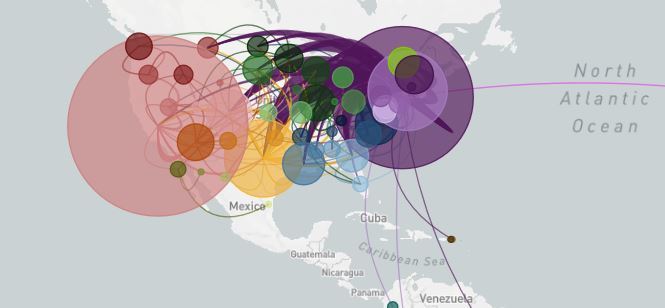|
 December 2019
|
|
Maintaining Biosafety Level 3 (BSL-3) Testing Capabilities is Critical for Performing Clinical Confirmatory Testing for Eastern Equine Encephalitis Virus
Jessica Jenkins, Kristine Smith, Diana Riner - MDHHS Bureau of Laboratories

When people think of mosquito-borne diseases, West Nile virus is usually what comes to mind. Most people have never heard of a virus called Eastern equine encephalitis virus, usually referred to as “EEE” or “triple E”. Though it’s not as well known, EEE has been present in Michigan for decades. Per the CDC, human cases of neuroinvasive EEE are sporadic, with only seven cases reported in Michigan from 2009-2018. In 2019 however, ten human cases of EEE were reported in Michigan with six fatalities. Testing for EEE requires highly trained microbiologists and special laboratory space as arboviruses can cause severe disease in humans. Michigan is one of seven places in the US capable of performing EEE confirmatory testing.
|
The Michigan Department of Health and Human Services (MDHHS) Bureau of Laboratories (BOL) provides arbovirus testing for the State of Michigan. The arbovirus panel at the BOL includes West Nile virus (WNV), St. Louis encephalitis virus (SLE), EEE, and California group virus- Lacrosse antigen (CGV). The screening test for arboviruses detects IgM antibodies in cerebrospinal fluid. Patient samples that are positive or inconclusive by the IgM test will undergo a confirmatory test known as the “plaque reduction neutralization test” or “PRNT”. As antibodies produced against one arbovirus can weakly bind to other arboviruses and “cross-react”, the combination of IgM testing and the confirmatory PRNT are often needed for confirmation of infection.
Maintaining Biosafety Level 3 Capabilities >>
|
|
Planning for People with Mental Health Needs During Emergencies
Alice Frame - MDHHS Disabilities Health Unit Coordinator
Disaster and trauma can cause stress, anxiety, and depression in individuals who may not have a history of mental illness, and they can magnify symptoms of those who do. Planning for the needs of those with mental illness during an emergency is a vital part of disaster preparedness; consider the following needs for people with mental illness:
1. Access to mental health professionals
2. Access to medication
3. Training for first responders
Mental Health Needs During Emergencies >>
|
|
Twenty Years of West Nile Virus Spread and Evolution in the Americas Visualized by Nextstrain
To bring new attention to one of the most important mosquito-borne viruses in the Americas, the authors provide an interactive review using Nextstrain: a visualization tool for real-time tracking of pathogen evolution (nextstrain.org/WNV/NA). Using Nextstrain, they use virus genomics to investigate the emergence of West Nile virus in the US, followed by its rapid spread, evolution in a new environment, establishment of endemic transmission, and subsequent international spread. Overall, their review showcases how genomics can track West Nile virus spread and evolution, as well as potentially uncover novel targeted control measures to help alleviate its public health burden.
West Nile Virus Spread and Evolution >>

|
|
|
Tools & Resources
Health Assessments for Disaster Shelters
The Centers for Disease Control and Prevention (CDC) has developed the Environmental Health Assessment Form for Disaster Shelters to assist environmental health practitioners in conducting a rapid assessment of shelter conditions during emergencies and disasters.
The form is intended to quickly identify immediate public health threats and their sources. CDC encourages modification of the tool to meet unique, local needs.
Includes general assessment of:
- Food Safety
- Water Quality
- Health & Medical
- Sanitation & Hygiene
- Waste Management
- Childcare Areas
- Sleeping Areas
- Pet & Service Animal Wellness
- Immediate Needs
Environmental Health Assessment Form for Disaster Shelters
Environmental Health Disaster Shelter Guide
|
|
Trainings & Events
EMS Safety Webinar 1 - Fatigue Mitigation
Live Webinar
January 22, 2020
This webinar is the first of a series focused on EMS Safety supported by the EMSCC EMS Safety Ad-Hoc Subcommittee. EMS Professionals will receive 1 preparatory credit on completion.
Register: MI-TRAIN Course ID #1088718
National Disaster Life Support Instructors Course
In-Person Training
February 13, 2020
This course will review the latest educational materials from the National Disaster Life Support (NDLS) and provide a foundation for teaching Basic and Advanced Disaster Life Support classes.
Instructors:
Dr. William Fales, EMS Medical Director Judy Wheeler, NDLS Coordinator
Register: MI-TRAIN Course ID #1088710
|
|
|
 |
|
The Guardian of Public Health is a monthly newsletter from the Bureau of EMS, Trauma and Preparedness (BETP) within the Michigan Department of Health and Human Services (MDHHS). The Guardian aims to provide readers with relevant content on topics that affect the public health of Michigan's citizens and communities. |
|
|
|
This publication was supported by Cooperative Agreement number 1NU90TP922062-01-00, funded by the Centers for Disease Control and Prevention. Its contents are solely the responsibility of the authors and do not necessarily represent the official views of the Centers for Disease Control and Prevention or the Department of Health and Human Services.
Bureau of EMS, Trauma & Preparedness | 1001 Terminal Rd, Lansing, MI 48906 | 517-335-8150
|
|
|
|